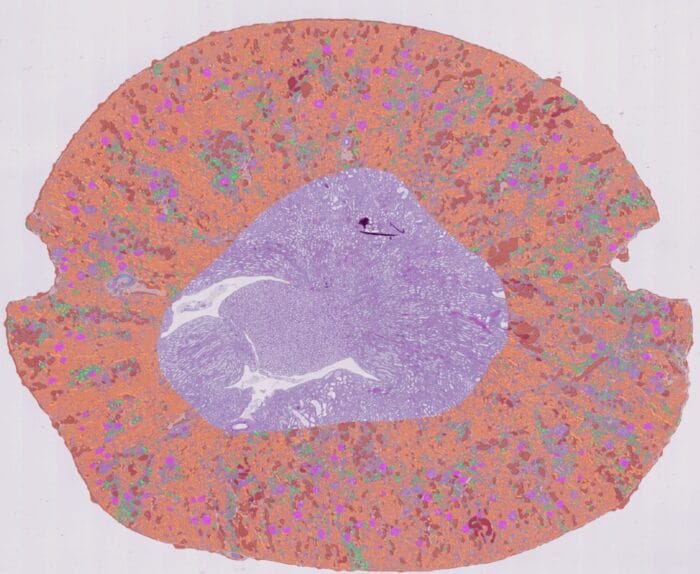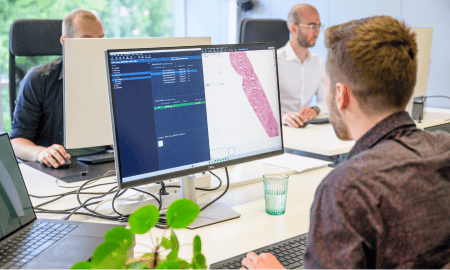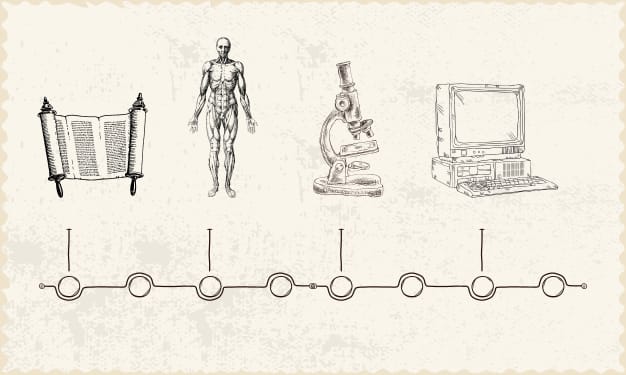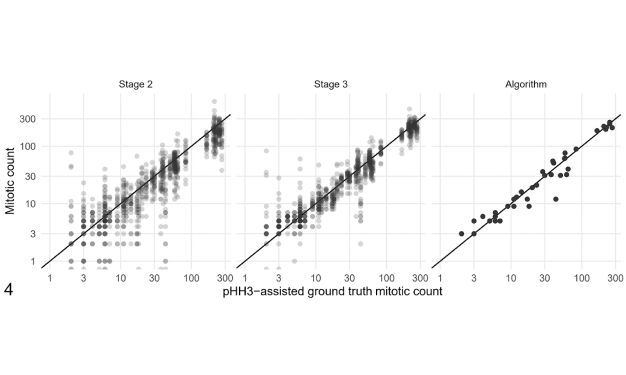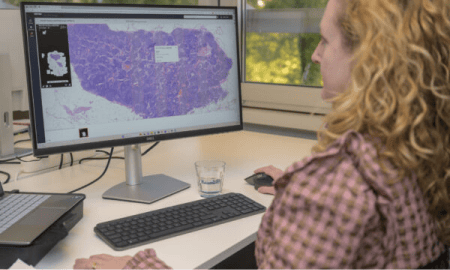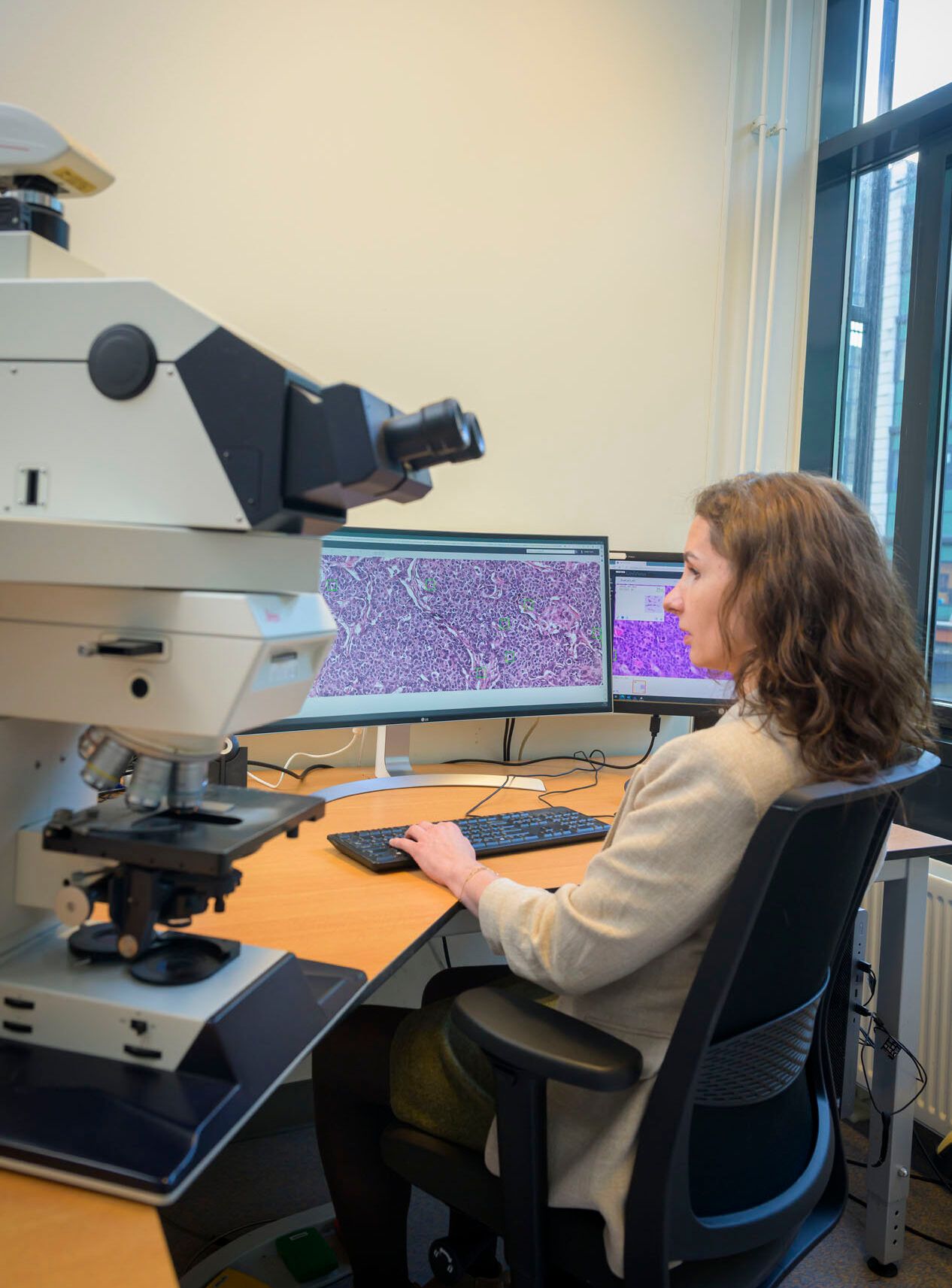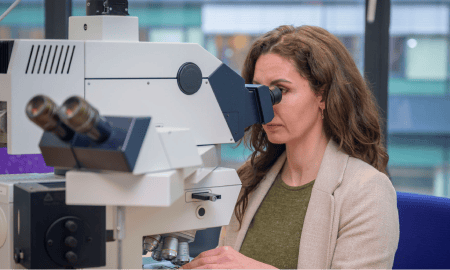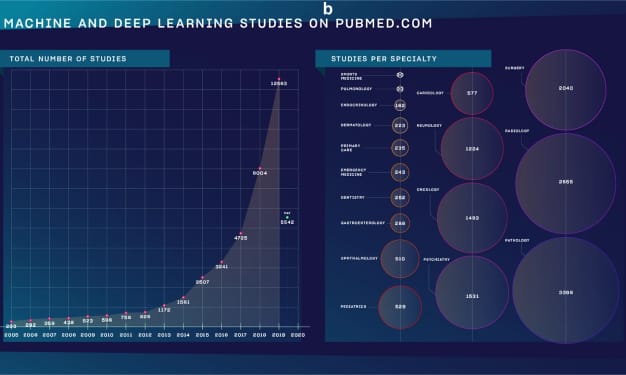Artificial intelligence is empowering pathologists and improving diagnostics
In the era of rapid AI advancement, a question often arises: will AI replace human jobs? The answer to the question is not clear, as it is a nuanced matter that involves various factors. AI has the potential to impact job roles, both by automating certain tasks and by creating new opportunities. Rather than focusing on replacing humans, the purpose of AI is to assist and augment human capabilities. While AI can bring significant advancements and efficiencies to various domains, it lacks the complex cognitive abilities, creativity, empathy, and intuition that are inherently human. Instead of replacing humans, AI serves as a valuable tool, working alongside professionals to enhance their work, streamline processes, and unlock new possibilities. By embracing AI, we can harness its potential to augment human capabilities and usher in a future where humans and AI collaborate, creating a synergy that leads to unprecedented advancements and improved outcomes.
The field of pathology is currently facing a critical challenge—an alarming decline in the number of pathologists alongside an escalating number of cancer cases. Projections indicate that by 2030, there will be a shortage of around 5,700 pathologists in the US only,1 further straining an already burdened field. In the face of these challenges, innovative solutions leveraging the power of AI offer a promising path forward. The transition from traditional microscope-based workflows to digital pathology has brought numerous advantages, allowing pathologists to analyze samples with greater convenience and efficiency by scanning biopsy tissues into high-resolution whole slide images. Moreover, digital pathology workflows enable the use of deep learning algorithms that support image analysis.
In recent years, AI has emerged as a game-changer in the medical field, making significant strides in digital pathology. By harnessing the power of AI, pathologists can unlock a new realm of possibilities that enhance the quality, accuracy, and efficiency of their work. In this blog post, we’ll delve into the benefits as well as the challenges AI brings to the digital pathology workflow.
Machine learning in pathology – benefits and opportunities
In the rapidly evolving field of pathology, the introduction of AI has brought numerous benefits that are revolutionizing the diagnostic process. From enhancing the workflow efficiency to improving accuracy, AI algorithms are reshaping the way pathologists work. In this section, we will explore the remarkable advantages that AI brings to pathology:
Improved workflow efficiency
The integration of AI into the daily practice of pathologists is rapidly becoming commonplace. With the advancements in AI technology, manual tasks that were once considered time-consuming and tedious can now be easily automated to aid pathologists. For instance, software has emerged that is capable of enhancing workflow efficiency through automated quality control. This eliminates the need for laboratory technicians to spend excessive time conducting manual checks on the quality of whole slide images. Another example is mitosis counting, a crucial biomarker for cancer diagnosis which has been described as a laborious task for pathologists. However, an article published in the Diagnostic Pathology Journal aimed to assess the efficiency and accuracy of an AI tool designed to quantify mitosis in breast tissues revealed that pathologists using the tool experienced a 27.8% reduction in time spent compared to manual methods.2 This and other remarkable advancements not only save valuable time but also empower pathologists to shift their attention to more critical aspects.
Increased diagnostic accuracy
AI algorithms have the potential to significantly enhance diagnostic accuracy. By analyzing vast amounts of data, AI can detect patterns and anomalies that might escape the human eye. Rare events, such as rare subtypes of tumors or unusual morphological features, can be challenging to identify and accurately classify. AI algorithms excel in recognizing patterns and anomalies, making them invaluable tools for detecting and characterizing rare events. This capability opens new possibilities for early detection, targeted therapies, and improved prognosis for patients with rare or atypical presentations. This collaboration between pathologists and AI ensures a more comprehensive analysis, leading to better-informed treatment decisions and improved patient care.
Reduced variability
Tumor grading plays a critical role in assessing the severity and aggressiveness of cancer. However, the subjective nature of human interpretation and variability in grading can lead to inconsistent results. AI offers a valuable solution by providing advanced decision-making support to pathologists when analyzing whole slide images. AI algorithms enable standardization by offering objective and quantifiable measures for tumor grading. With significant advancements in AI development, these algorithms deliver accurate results in most cases. By incorporating AI into the process, pathologists can ensure standardized tumor grading, leading to improved treatment decisions and patient outcomes.
In a study published in the Nature Journal3, researchers aimed to develop an automated scoring system for nuclear pleomorphism in breast cancer. To evaluate the variability in grading, four pathologists were asked to assign pleomorphism scores to 118 whole slide images. The discrepancies in grading were startling, highlighting the impact of variability on daily diagnoses (Figure 1). In contrast, the AI algorithm offered a standardized approach to scoring. These findings are a good example of the potential of AI to mitigate variability and provide a consistent and reliable assessment of tumor characteristics.

Source: Figure 6. retrieved from Mercan, C., et al. (2022). Deep learning for fully-automated nuclear pleomorphism scoring in breast cancer. npj Breast Cancer. https://doi.org/10.1038/s41523-022-00488-w
Personalized medicine
One of the most promising opportunities AI brings to digital pathology is the advancement of personalized medicine. By analyzing extensive patient data, including genomics and medical histories, AI algorithms can identify unique patterns and biomarkers associated with specific diseases. This information enables tailored treatment plans that consider individual characteristics, optimizing patient care and outcomes. The integration of AI in personalized medicine holds the potential to revolutionize healthcare, providing targeted therapies and improving patient well-being.
Challenges of AI in pathology
However, the implementation of AI in digital pathology poses challenges such as clinical integration, regulatory and ethical concerns, and the need for prospective validation. Successfully addressing these challenges is crucial for ensuring the seamless integration and adoption of AI models into real-world clinical workflows.
Data availability and quality for validation
AI algorithms heavily rely on large volumes of high-quality data for training and validation. However, accessing comprehensive and diverse datasets can be challenging due to issues such as data fragmentation, lack of standardization, and data privacy concerns. Ensuring the availability of representative and annotated datasets is essential for training accurate and robust AI models.
Regulatory and ethical considerations
The implementation of AI algorithms in medical settings requires regulatory approvals, which can be a complex and time-consuming process. Compliance with strict data protection regulations, as well as adherence to ethical guidelines, is vital to uphold patient confidentiality and trust. Ethical considerations include bias in training data, algorithmic discrimination, and decision-making responsibility. Striking the right balance between human expertise and AI assistance is crucial to maintain ethical standards and ensure accountability in patient care.
Integration into clinical workflows
Successfully integrating AI algorithms into existing clinical workflows is a potential challenge. Despite the long-term efficiency gains and cost savings offered by artificial intelligence, implementing AI solutions requires a financial investment. The cost of acquiring, implementing, and maintaining AI systems may pose financial challenges for healthcare organizations. AI systems need to seamlessly integrate with existing workflows. Ensuring interoperability, compatibility, and ease of use are critical factors for acceptance and adoption by pathologists and healthcare professionals.
Embracing AI in medical diagnosis
By harnessing the power of AI while addressing its challenges, we can unlock the full potential of deep learning in pathology. AI in computational pathology is a catalyst for innovation and improved healthcare. The journey towards realizing the full potential of AI in pathology requires a thoughtful and comprehensive approach, but the benefits it offers make it a worthwhile pursuit for the future of healthcare.
References:
- Robboy, S. J., Weintraub, S., Horvath, A. E., Jensen, B. W., Alexander, C. B., Fody, E. P., Crawford, J. M., Clark, J. R., Cantor-Weinberg, J., Joshi, M. G., Cohen, M. B., Prystowsky, M. B., Bean, S. M., Gupta, S., Powell, S. Z., Speights, V. O., Jr, Gross, D. J., & Black-Schaffer, W. S. (2013). Pathologist workforce in the United States: I. Development of a predictive model to examine factors influencing supply. Archives of pathology & laboratory medicine. https://pubmed.ncbi.nlm.nih.gov/23738764/
- Pantanowitz, L., Hartman, D., Yan , Q., Eun , Y. C., Suh, B., Paeng, K., . . . Cho, S. Y. (2020). Accuracy and efficiency of an artificial intelligence tool when counting breast mitoses. Diagnostic Pathology. https://pubmed.ncbi.nlm.nih.gov/32622359/
- Mercan, C., Balkenhol, M., Salgado, R., Sherman, M., Vielh, P., Vreuls, W., . . . Ciompi, F. (2022). Deep learning for fully-automated nuclear pleomorphism scoring in breast cancer. npj Breast Cancer. https://www.nature.com/articles/s41523-022-00488-w
More Blogs
-
AI assistance in Chronic Kidney Disease monitoring
03 July, 2024 • By Kama Witkowska
Read more -
Behind the scenes of pathology AI innovation – Blazej Dolicki’s insights into training, validation, deployment, and beyond
18 June, 2024 • By Victoria Grosu
Read more -
A short overview of the history of pathology: origins, early days, and the transition to novel technologies
16 May, 2024 • By Kama Witkowska
Read more -
The benefits of AI implementation in mitotic figure counting
11 April, 2024 • By Kama Witkowska
Read more -
Diana Rosentul explains the complexities of regulatory compliance for integrating AI-based solutions in the healthcare industry
25 January, 2024 • By Diana Rosentul
Read more -
Cristina González Gonzalo discusses her journey with the clinical validation of Aiosyn Mitosis Breast
14 December, 2023 • By Anna Correas Grifoll
Read more -
Time to go digital? Navigating the pathology transition from microscopes to whole slide images
30 November, 2023 • By Victoria Grosu
Read more -
Prepare for the future: AI is changing the landscape of pathology
09 October, 2023 • By Victoria Grosu
Read more

